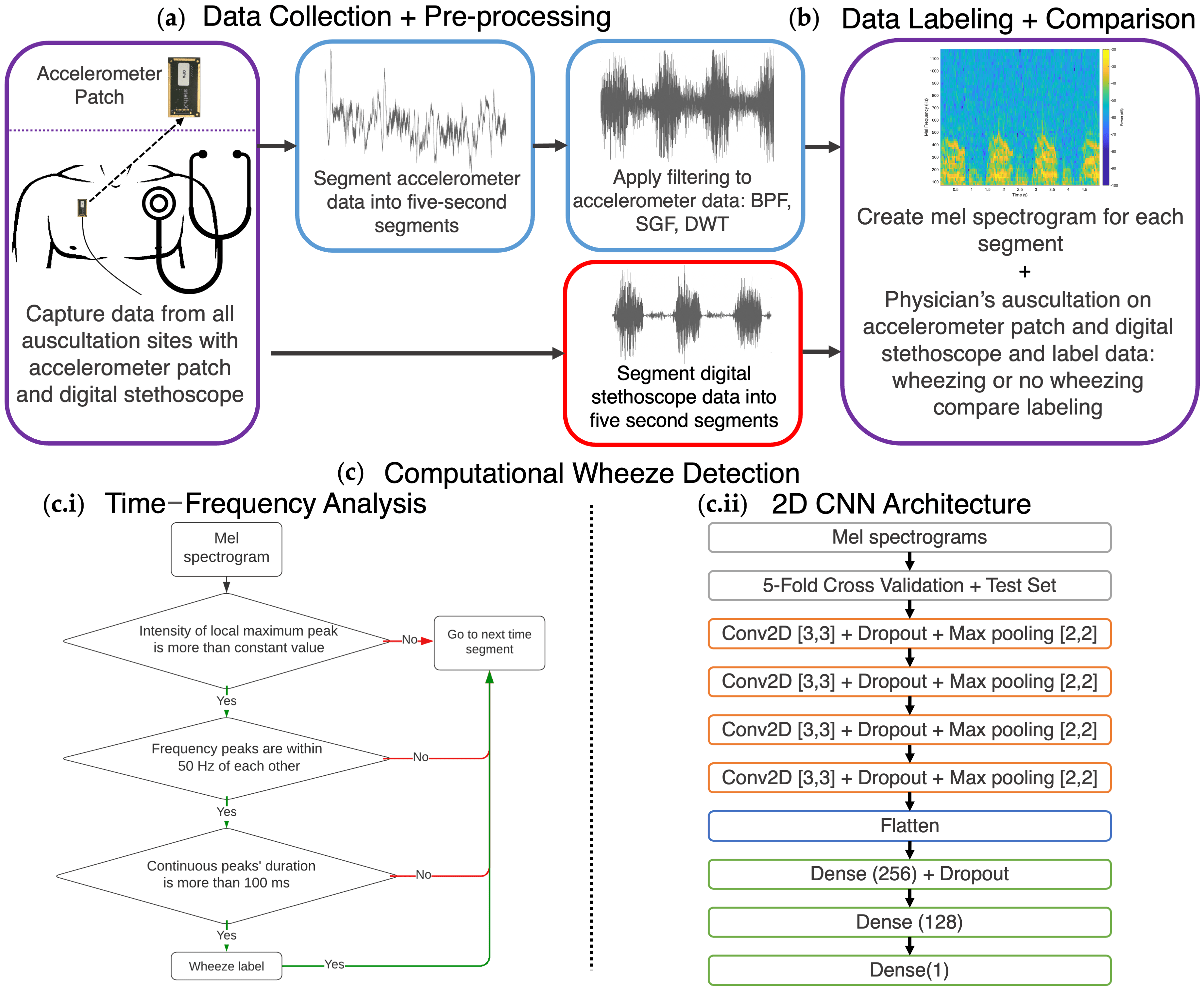New Publication Alert
An Accelerometer-Based Wearable Patch for Robust Respiratory Rate and Wheeze Detection Using Deep Learning
Brian Sang , Haoran Wen, Gregory Junek, Wendy Neveu, Lorenzo Di Francesco , and Farrokh Ayazi
Biosensors, (2024)
doi.org/10.3390/bios14030118
Wheezing is a critical indicator of various respiratory conditions, including asthma and chronic obstructive pulmonary disease (COPD). Current diagnosis relies on subjective lung auscultation by physicians. Enabling this capability via a low-profile, objective wearable device for remote patient monitoring (RPM) could offer pre-emptive, accurate respiratory data to patients. With this goal as our aim, we used a low-profile accelerometer-based wearable system that utilizes deep learning to objectively detect wheezing along with respiration rate using a single sensor. The miniature patch consists of a sensitive wideband MEMS accelerometer and low-noise CMOS interface electronics on a small board, which was then placed on nine conventional lung auscultation sites on the patient’s chest walls to capture the pulmonary-induced vibrations (PIVs). A deep learning model was developed and compared with a deterministic time–frequency method to objectively detect wheezing in the PIV signals using data captured from 52 diverse patients with respiratory diseases. The wearable accelerometer patch, paired with the deep learning model, demonstrated high fidelity in capturing and detecting respiratory wheezes and patterns across diverse and pertinent settings. It achieved accuracy, sensitivity, and specificity of 95%, 96%, and 93%, respectively, with an AUC of 0.99 on the test set—outperforming the deterministic time–frequency approach. Furthermore, the accelerometer patch outperforms the digital stethoscopes in sound analysis while offering immunity to ambient sounds, which not only enhances data quality and performance for computational wheeze detection by a significant margin but also provides a robust sensor solution that can quantify respiration patterns simultaneously.
Link to research article: Biosensors

New Publication Alert
A 0.34Deg/Hour Bulk Acoustic Wave Gyroscope in 4H Silicon-Carbide with an Elevated-Temperature Enhanced Q-Factor of 4.6 Million
Zhenming Liu, Yaoyao Long, Charlotte M. Wehner, Haoran Wen and F. Ayazi
2024 IEEE 37th International Conference on Micro Electro Mechanical Systems
DOI: 10.1109/MEMS58180.2024.10439512
This paper presents a comprehensive exploration of the first ovenized bulk acoustic wave (BAW) gyroscope implemented in thick monocrystalline silicon-carbide (SiC), showcasing sub-degree bias instability (BI) and superior angle random walk (ARW) compared to state-of-the-art planar silicon counterparts. Notably, the study delves into the positive temperature coefficient of Q-factor (TCQ) observed in semi-solid BAW disk SiC resonators, enabling ovenization at 80℃ and achieving a remarkable thermoelastic damping (TED) limited Q of 4.6 million at a high frequency of 3MHz. The findings highlight SiC, specifically in 4H-SiC, as a promising platform for next-generation MEMS precision positioning, navigation, and timing (PNT) devices.
Link to research article: IEEE International Conference on Micro Electro Mechanical Systems

New Publication Alert
4H-SiC Beam Resonators with Tailored Local Zero TCF
Yaoyao Long, Zhenming Liu, Xinyu Jiang and F. Ayazi
2024 IEEE 37th International Conference on Micro Electro Mechanical Systems DOI: 10.1109/MEMS58180.2024.10439318
For the first time, this paper unveils doubly-clamped beam resonators in monocrystalline 4H-silicon carbide (4H-SiC) with a tailorable local zero temperature coefficient of frequency (TCF). This innovation utilizes axial stress to counteract the temperature-driven softening of the 4H-SiC beam using the layered structure of 4H silicon carbide on insulator (SiCOI) substrate with a silicon handle layer. We demonstrate the ability to define the TCF turnover point anywhere in the range of −20 ~ 100℃ by tailoring the beam aspect ratio. We also delve into the stability attributes of the 4H-SiC microresonator, charting this terrain for the very first time.
Link to research article: IEEE International Conference on Micro Electro Mechanical Systems
New Publication Alert
A Review of Eigenmode and Frequency Control in Piezoelectric MEMS Resonators
Zhenming Liu and F. Ayazi
IEEE Transactions on Ultrasonics, Ferroelectrics, and Frequency Control 70, 10 (2023). DOI: 10.1109/TUFFC.2023.3285084
Piezoelectric microelectromechanical systems (MEMS) resonators possess favorable properties, such as strong electromechanical coupling, high Q , and polarized linear transduction, making them ideal for various applications, including timing, sensing, and RF communication. However, due to process nonidealities and temperature variations, these resonators characteristics may deviate from their designed frequency and resonant eigenmode, requiring careful compensation for stable and precise operation. Furthermore, certain devices, such as gyroscopic resonators, have two eigenmodes that need to be adjusted for frequency proximity and cross-mode coupling. Therefore, mode-shape manipulation can also be important in piezoelectric resonators and will be another focus of this article. Techniques for frequency and eigenmode control are classified into device- or system-level tuning, trimming, and compensation. This article will compare and discuss the effectiveness of these techniques in specific applications to provide a comprehensive understanding of frequency and eigenmode control in piezoelectric MEMS resonators, aiding the development of advanced MEMS devices for diverse applications.
Link to research article: IEEE Transactions on Ultrasonics, Ferroelectrics, and Frequency Control

New Publication Alert
4H-Silicon Carbide as an Acoustic Material for MEMS
Yaoyao Long, Zhenming Liu and F. Ayazi
IEEE Transactions on Ultrasonics, Ferroelectrics, and Frequency Control 70, 10 (2023). DOI: 10.1109/TUFFC.2023.3282920
This article discusses the potential of 4H-silicon carbide (SiC) as a superior acoustic material for microelectromechanical systems (MEMS), particularly for high-performance resonator and extreme environments applications. Through a comparison of the crystalline structure along with the mechanical, acoustic, electrical, and thermal properties of 4H with respect to other SiC polytypes and silicon, it is shown that 4H-SiC possesses salient properties for MEMS applications, including its transverse isotropy and small phonon scattering dissipation. The utility and implementation of bonded SiC on insulator (4H-SiCOI) substrates as an emerging MEMS technology platform are presented. Additionally, this article reports on the temperature-dependent mechanical properties of 4H-SiC, including the temperature coefficient of frequency (TCF) and quality factor ( Q -factor) for Lamé mode resonators. Finally, the 4H-SiC MEMS fabrication including its deep reactive ion etching is discussed. This article provides valuable insights into the potential of 4H-SiC as a mechanoacoustic material and provides a foundation for future research in the field.
Link to research article: IEEE Transactions on Ultrasonics, Ferroelectrics, and Frequency Control

